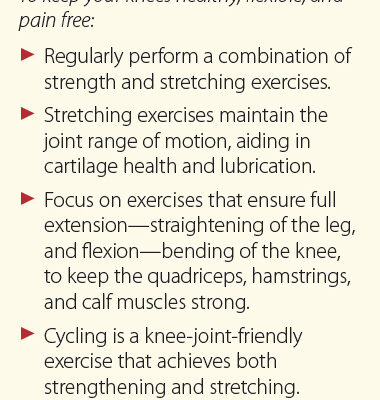Explore Your Options For the Best Knee Pain Treatment
When knee pain gets in the way of things you have to do, such as grocery shopping, or things you like to do, such as taking walks with your grandchildren or dog, it may be time to consider treatment options so you can regain comfort and mobility.
In healthy knees, a gel-like substance called synovial fluid lubricates the joints, allowing the bones to glide over each other. As you get older, the synovial fluid may become thinner, allowing the bones to rub against each other and causing the cartilage to become rough and eventually wear away. The resultant rubbing of bone on bone can cause pain, stiffness, and swelling.

Depending on the extent or cause of your discomfort or pain, an effective solution will fall into one or more of these categories: Rest, nonsteroidal anti-inflammatory drugs (NSAIDS), injections, or surgery.
Rest, Ice, and NSAIDs
Osteoarthritis (OA) is the most common cause of knee pain. An estimated 14 million people in the U.S. have knee osteoarthritis, and, among adults ages 50 and older, a higher percentage of women than men are diagnosed with the condition, according to the Arthritis Foundation. Treatment for osteoarthritis, is usually rest, ice, and/or taking NSAIDs.
If pain or swelling in the knee occurs with or after activity, it is best to rest the knee to avoid further aggravation. “In addition to rest, icing the knee should help reduce inflammation, and a compressive dressing such as an Ace bandage can help with swelling. Taking NSAIDs such as ibuprofen or naproxen can help bring down pain and swelling more quickly,” says Edwin Su, MD, an orthopaedic surgeon at Weill Cornell Medicine’s Hospital for Special Surgery.
Joint Injection Therapy
Injection therapy is popular because it has a high rate of efficacy and is minimally invasive. Knee injections fall into three categories: corticosteroids, viscosupplementation, and stem cell/platelet rich plasma (PRP) injections. “The benefits of injections are that they may reduce knee pain and improve function, helping one avoid surgery. However, if the condition within the knee is significantly degenerative, then these treatments are temporary and may not be fully effective,” says Dr. Su.
Corticosteroids commonly used in injections include hydrocortisone and methylprednisolone. “Cortisone is a potent anti-inflammatory medication, so injecting it into the knee is generally an effective pain reliever. But it shouldn’t be given too frequently, as it doesn’t correct any underlying problem and may actually increase cartilage wear,” says Dr. Su. Steroid injections are generally always covered by insurance.
Viscosupplementation entails the injection of hyaluronic acid (HA)—a thick gel-like substance—to cushion the knee joint. “The purpose of HA injections is to preserve the cartilage that is already in the knee and enhance its function. It is thought of as a more preventative treatment and may last longer than cortisone,” says Dr. Su. But there’s a downside, as well. “The efficacy of these injections is less predictable than cortisone, and they are not covered by all types of insurance. Furthermore, if the knee joint already has bone-on-bone contact, it is probably too far gone for this type of injection,” he says.
Stem-cell and platelet rich plasma (PRP) injections are another option. These substances are obtained from the patient’s own fat or bone marrow. “These injections hold the promise of “regenerating” cartilage; however, they have yet to be proven as more effective than cortisone. These injections tend to be more invasive than other injections and are not covered by insurance,” explains Dr. Su.
Knee Replacement Surgery
When rest, NSAIDs, and injections don’t sufficiently relieve pain, total knee replacement (TKR) surgery may be an option. “The newest developments in TKR surgery have a lot to do with improvements in the anesthesia that we use, making the recovery process quicker and less painful,” said Dr. Su.
Consider All Your Options
There are a variety of pain relief options at your disposal. Talk with your doctor about your knee pain, and depending on the extent of your discomfort, one or more of these interventions may be right for you.
The post Explore Your Options For the Best Knee Pain Treatment appeared first on University Health News.
Read Original Article: Explore Your Options For the Best Knee Pain Treatment »


